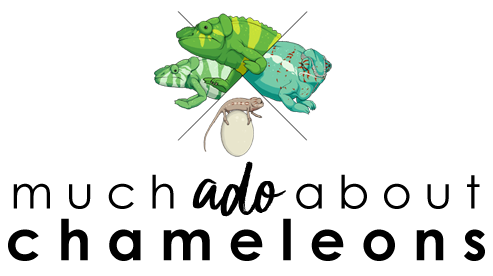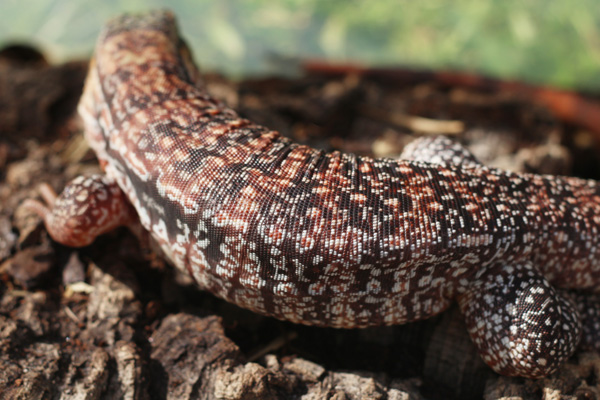Most people have been here at some point. They're going on vacation or need to leave town for a few days and they think... what do we do with the reptiles? It's one thing to leave cats and dogs in a kennel but it's another thing to find someone to lodge your reptiles, especially if you have delicate ones like chameleons or have more than one or two. Just the cost of boarding reptiles at experienced pet stores or vet offices can be prohibitive if you have multiple animals or are leaving for a long time.
So below are my tips on how to leave your chameleons at home if you elect to do this. I think letting your chameleons stay at home in their own cages is the best way to make sure that their life remains stress-free, that they don't catch an infection or parasites from other animals in boarding, and that their conditions remain ideal.
WHEN & HOW TO LEAVE THEM HOME ALONE
This option makes people nervous, understandably, but this is the option I use most often. However, to be safe it depends on a few factors:
- Your set-up must be fully automated. This means that you have lights and a misting system on a reliable timer, so that their heat and water is provided automatically.
- You do not have very young chameleons (under 6-8 months old) who should not skip 2-3 days of food.
- You do not have sick or weakened chameleons (or laying females) who could suddenly get worse or need daily attention, medication, or supervision.
- You do not live in an area that is prone to power outages or severe weather, at least during the time of your trip, that could leave the chameleons alone during life-threatening conditions (such as severe snow storms or hurricanes.)
- You will only be gone 2-4 days.
So, if I have a house full of healthy chameleons that are all fully grown, eating every couple days, and have a fully automated set-up, I feel pretty comfortable feeding them on Friday, filling up their misting water reservoir, emptying out the drainage buckets, and leaving for the weekend. They will be fine not eating until the next Monday or Tuesday, and will have sufficient water for that length of time. Additionally, if the worst case scenario happens and something goes wrong with their lights* or water, they will not be harmed by going without for 2-3 days (at least in most typical homes, where temperatures stay pretty mild.)
*Tip: One reason I much prefer halogen spot lights for basking over incandescents is that the latter are extremely prone to burning out at the worst possible times, especially the cheap, multi-pack ones. I used to replace my incandescent bulbs quite often, where as I've had the same halogen bulbs now for 2 full years without replacing. So, when it comes to reliability I definitely prefer halogen bulbs. Little more money and a significant increase in dependability!
WHEN & HOW TO TRAIN A CHAMELEON BABYSITTER
In some cases, however, it is much better to have a pet sitter come by daily or every few days to check in on your reptiles instead of leaving them to their own devices:
- When your set-up is not automated, or at least not your misting system.
- When your chameleon is very young (under 6 months), weak, sick, or laying eggs. They will need daily feeding, medicine, or supervision to make sure nothing goes wrong.
- When you are leaving for longer than about 3-4 days.
- When extenuating circumstances mean that visits are a good idea, such as inclement weather, common power outages, etc.
When I do a longer trip away, such as a week or two, (and I only have adult chameleons) I will generally only make a pet sitter come by every 2 days. This is usually enough to make sure that the chameleons are fed, their water reservoir is re-filled, their drainage dumped away, and to make sure everyone is doing well. If I have babies or chameleons that need medicine, I will requite a sitter to come by every day. If you do not have an automated set-up (especially water), I would strongly recommend that you have them come by every day*. A combination of misting and having a large-sized dripper should be sufficient to make sure they have adequate water all day.
*Tip - Invest in a light timer, at least! They are extremely affordable. Otherwise a sitter will have to come once in the morning to turn on the lights and again to turn them off at night.
But how do you make sure your sitter knows what to do?
I usually end up recruiting friends or family who volunteer to help, but a professional sitter will be more reliable. However, the problem with chameleons is that even most professional sitters do not have a lot of experience with these specialized animals, so it becomes a challenge making sure that whoever you choose will take care of them properly.
My tips to making sure that even an inexperienced friend does well are as follows:
- Keep things simple! Do not confuse or overwhelm a sitter with a 20-page care-sheet. They do not need to learn all about supplements or gut loading to do a good job, and overwhelming them with too much information or too many things to do will only make it more likely that they forget or skip those things altogether. So show them how to mist, feed, and clean, but do not get carried away. Consider skipping all supplements besides plain calcium for the duration of the trip, as giving one supplement is much easier than alternating between 3, for example.
- Leave as much prepared before you leave as you can. When I go away, I will leave small zip-lock baggies in the fridge prepared with pre-cut fruits and veggies for gutloading the bugs so that the sitter can simply throw the contents into the bins and move on. Or I will leave tiny plastic cups with the proper supplement and dose (write the day on the cup with a Sharpie, like Mon., Tues., Wed., etc.) so that they then only have to catch up bugs in a cup, dump in the little dose of calcium, swirl, and place in the cage. Doing little things like these for a sitter will ensure that things are not only easier for the sitter but that they are done correctly.
- Leave very simple, easy to follow schedules. As with resumes or cover letters, these things should be ONE page long, and no longer. Usually, a large, easy to read calendar with chores or instructions is best, or bullet-point lists. Handing a person a long-wordy care-sheet is a guarantee that nothing will be read.
By keeping things as simple as possible you're more likely to enjoy a seamless pet-sitting experience, and will be able to enjoy your vacation in peace. In all the years I've been keeping chameleons I have yet to have a bad experience with a pet sitter, whether they are friends or professionals, by keeping things simple and easy.
{ NEW }
I got this really helpful idea from a reader that I thought was worth sharing:
"I wrap my supplement containers in different colored bright tape, so when I leave on vacation I color in the days on the calendar that correspond with each supplement. This makes it much easier for someone new, who may become confused by the 'calcium noD' or 'Calcium high-D' on the labels."
Love this idea! Simple, simple, simple.












Hi Olimpia, we go on vacation for 6 weeks every 2 years, What do we do?
ReplyDelete6 weeks is a long time! If this is a vacation where you could take the chameleon with you, cage and all, I would. If not you hay have to find someone that can keep the chameleon at their house for that length of time. It may come down to what is most cost-effective. I don't think hiring someone to come by daily for 6 weeks is feasible. But if you can train a friend or family member, then maybe that is a solution.
DeleteOr see if there are any chameleon breeders or hobbyists in your area that might be interested in babysitting at their house. That might incur some sort of payment but it may be relatively reasonable.
Hello! Do you have any recommendations of automatic timers and misters. I want to become a chameleon owner, but have to invest in an automatic setup before I do because I frequently take weekend trips with my wife.
ReplyDeleteThank you for your help!
Thanks for reaching out! I am still a big fan of the Mistking starter system, but I am starting to hear great things about the Climist Cyclone system. It seems they are both comparable in size, capacity, cost, and quality so either one with their seconds timer seems like a good investment. It may seem silly to spend $100 on a misting system for a single chameleon but even years later I am so glad I have my Mistking, as I never have to worry about the geckos/chameleons going without water.
DeleteAs far as timers for the lights, I use a normal hour timer from a home improvement store. I know there are systems out there that dim the light on and off and control the temperature for you, like the Ecozone Vivarium system. I don’t know how much that system is going for now but it might be a worth-it investment. However, like I said I use a cheap 2-outlet timer and that turns all my lights on and off daily.
Thank you Olimpia! I thought my affinity for chameleons was a passing fad for me, but my interest has just grown over time. I recently rediscovered my interest in them after finding a beautiful veiled chameleon in my local pet store. I have visited every other day and it has just gone on sale. Really the long weekends we go away are the only thing holding me back right now. Any clever way you have found to feed them over a long weekend?
DeleteThank you for this excellent blog and the quick responses!
It happens! It was the same way for me, I discovered people were keeping chameleons as pets over a year before I decided to get my first. That’s how you know it’s probably “true love!”
DeleteThe great thing about reptile metabolisms is that they aren’t like us, they don’t need to eat every day. We do because we use most of our energy to maintain an internal body temperature, but reptiles bask for that so they can go through a day using very little energy. So I think that once an animal is above about 6 months of age I would be comfortable not feeding them all weekend. And by that I mean that I would feed daily every weekday, feed well on Friday, and (if you can get him used to feeding from a cup) I’d leave some bugs in the cup for him. That way he has something to eat on Saturday and realistically he only goes Sunday and Monday without food, which is fine.
Small babies I would prefer to feed daily still but once they are a little older I am comfortable leaving them alone 2-3 days.
Hello,
ReplyDeleteI am adopting a veiled chameleon that has a calcium deficiency and pretty much needs to be syringe fed critical care diet as she only eats about 2 small crickets every now and again on her own. She only weighs .75oz now. I am leaving for 5 days in October and I'm afraid that she won't make it. I also have a cat and I'm trying to find the beat setup for this chameleon. Any suggeations?
Where do you live? Does she eat from the syringe or get injected? I'm in Pittsburgh, PA if you are not, try 'non-box' pet stores in your area that specialize in reptiles. Also you could try an appeal with a YouTube video, I've seen a lot of young bright chameleon owners out there! Good luck
ReplyDeleteYour blogs are easily accessible and quite enlightening so keep doing the amazing work guys.
ReplyDeletekbmdc.org/
Hello,
ReplyDeleteI'll be leaving for vacation and gone for 9 days.
I have purchased a mistking starter kit and have my uvb and basking light on a 12 hour timer. My concern is food. I've been told I could buy some fruit flies in larva stage and they will hatch a few days after the food runs out. Is it not recommended to have a few feeder cups setup with crickets and other grubs or will they overeat?
Setup
24x24x48 screen bioactive terrarium
2ft uvb
75w agro spotlight
4 ft Ficus
Will have a mistking with 5 or 10 gallon drum/tote.